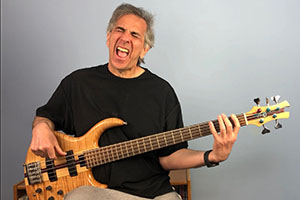Here we go again. The debate continues…
By Jon Liebman
Week of May 11, 2020
When you first started learning bass, chances are you began on a 4-string.
Today, no matter how many basses you own, I bet you have one or two primary “go-to” basses you instinctively reach for first. How many strings do they have? And why?
This topic comes up a lot with bass players. I’ve written about it in other blogs. But it surfaced yet again in my interview with Robert Harper, published this week on FBPO.
Like most bass players, Robert started on a 4-string. When he saw the basses in a music store, next to all the guitars, he noticed they only had four strings. “I was smart enough to know that 4 strings looked easier than 6,” he says, recalling his naivete.
Fast-forward a couple decades, and Robert doesn’t even play 4-strings any more. Why?
When he first discovered the bass, it was the funk players that immediately got Robert’s attention. He cites Louis Johnson and Larry Graham as primary influences. I went “straight for the funk,” he says.
These days, Robert plays in Area 301, a Maryland-based hip-hop fusion band, and his 4-strings have gone by the wayside. “I just feel strange with them now,” he says. “I play 5 and 6.”
Now that the novelty of having more than four strings on a bass has essentially subsided – remember the out-of-control 5- and 6-string craze back in ‘80s?! – we bass players have more choices than ever in deciding what works best for our specific situations.
At For Bass Players Only, 99% of my lessons are presented with a 4-string in mind (Joe Santerre’s fabulous 6-string courses are the only exceptions). Still, my students can apply just about all the concepts, grooves, techniques, etc. to basses with 5, or 6 – or any number of strings.
“Little did I know they would do all this new stuff they’re doing nowadays,” Robert says, “but back then, I was on it,” playing 4-string funk.
When you come right down to it, learning bass means learning to groove. And that’s always been the focus at For Bass Players Only, no matter how many strings a player prefers.
I’ve said it a thousand times: “Groove is everything, and everything must groove.” That’s what a bass player needs to understand, more than anything else.
Have a thought on the subject? Leave a comment below and let me know what you think. In the meantime, check out my interview with Robert here.
At For Bass Players Only, we take the frustration out of learning bass, so you can build confidence and thoroughly enjoy making music. Sign up for your free trial membership. Let’s play bass!






I played 4 String for a while then i started to feel limited in terms of range so i went to a 6 string.Now i’m comfortable playing 4 5 & 6 string Basses.But when it comes to recording i have my Music Man 5 string .
According to Paul Brun’s book “A New History of the Double Bass”, most of the original acoustic basses had 5 strings. It wasn’t until the 17th century that 4 stringers started to be the norm. And to this day, some symphony orchestras have 5 string uprights in order to play the music that was written for them. Anthony JAckson does fine on a 6 string and Victor Wooten gets along with 4. I switched to 5 strings around 2000 and love my Elricks. But I still pick up my 62 P-Bass every once in a while takes me back and reminds me that there are different ways to play. (Advantage with a 5 string – low Eb for all those jazz tunes in flat keys.) As Delbert McClinton sang “It ain’t what you eat but the way how you chew it.”